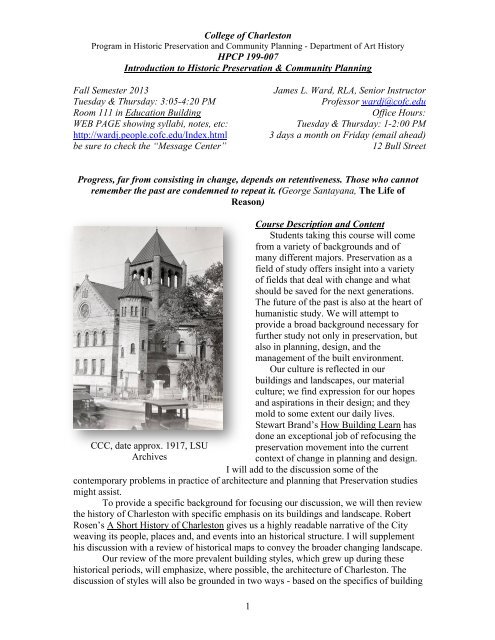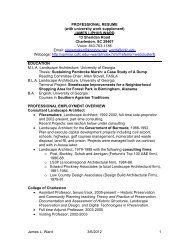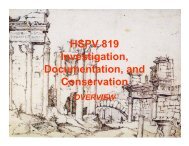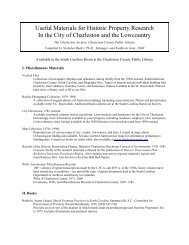1) HPCP 199 Introduction to Historic Preservation - Home Page
1) HPCP 199 Introduction to Historic Preservation - Home Page
1) HPCP 199 Introduction to Historic Preservation - Home Page
You also want an ePaper? Increase the reach of your titles
YUMPU automatically turns print PDFs into web optimized ePapers that Google loves.
College of Charles<strong>to</strong>nProgram in His<strong>to</strong>ric <strong>Preservation</strong> and Community Planning - Department of Art His<strong>to</strong>ry<strong>HPCP</strong> <strong>199</strong>-007<strong>Introduction</strong> <strong>to</strong> His<strong>to</strong>ric <strong>Preservation</strong> & Community PlanningFall Semester 2013Tuesday & Thursday: 3:05-4:20 PMRoom 111 in Education BuildingWEB PAGE showing syllabi, notes, etc:http://wardj.people.cofc.edu/Index.htmlbe sure <strong>to</strong> check the “Message Center”James L. Ward, RLA, Senior Instruc<strong>to</strong>rProfessor wardj@cofc.eduOffice Hours:Tuesday & Thursday: 1-2:00 PM3 days a month on Friday (email ahead)12 Bull StreetProgress, far from consisting in change, depends on retentiveness. Those who cannotremember the past are condemned <strong>to</strong> repeat it. (George Santayana, The Life ofReason)CCC, date approx. 1917, LSUArchivesCourse Description and ContentStudents taking this course will comefrom a variety of backgrounds and ofmany different majors. <strong>Preservation</strong> as afield of study offers insight in<strong>to</strong> a varietyof fields that deal with change and whatshould be saved for the next generations.The future of the past is also at the heart ofhumanistic study. We will attempt <strong>to</strong>provide a broad background necessary forfurther study not only in preservation, butalso in planning, design, and themanagement of the built environment.Our culture is reflected in ourbuildings and landscapes, our materialculture; we find expression for our hopesand aspirations in their design; and theymold <strong>to</strong> some extent our daily lives.Stewart Brand’s How Building Learn hasdone an exceptional job of refocusing thepreservation movement in<strong>to</strong> the currentcontext of change in planning and design.I will add <strong>to</strong> the discussion some of thecontemporary problems in practice of architecture and planning that <strong>Preservation</strong> studiesmight assist.To provide a specific background for focusing our discussion, we will then reviewthe his<strong>to</strong>ry of Charles<strong>to</strong>n with specific emphasis on its buildings and landscape. RobertRosen’s A Short His<strong>to</strong>ry of Charles<strong>to</strong>n gives us a highly readable narrative of the Cityweaving its people, places and, and events in<strong>to</strong> an his<strong>to</strong>rical structure. I will supplementhis discussion with a review of his<strong>to</strong>rical maps <strong>to</strong> convey the broader changing landscape.Our review of the more prevalent building styles, which grew up during thesehis<strong>to</strong>rical periods, will emphasize, where possible, the architecture of Charles<strong>to</strong>n. Thediscussion of styles will also be grounded in two ways - based on the specifics of building1
ana<strong>to</strong>my and its development, and on the cultural, his<strong>to</strong>rical, and technical issues of eachtime frame.We will review the types of practice involved in the management of our builtenvironment. This will emphasize the cura<strong>to</strong>rial arts in a more defined way and give apractical sense of how artifacts of all types are preserved and presented. This spells outthe opportunities for the practice of His<strong>to</strong>ric <strong>Preservation</strong> in detail and the varied natureof our efforts professionally.Finally, students’ sensibility about managing the built and natural environmentwill be enhanced by developing and presenting a research report: a landscape his<strong>to</strong>ricalanalysis concerning a specific Charles<strong>to</strong>n site. This report will be an opportunity <strong>to</strong> bring<strong>to</strong>gether the content of the course in a focused practical way as we will analyze the site,its buildings, and its graveyard. Miscellaneous lectures will deal with special researchtechniques and sources for His<strong>to</strong>ric <strong>Preservation</strong> and a preliminary look at Architectural,Landscape, and Urban Design/Planning Issues. This type of study points up theconnections between people and place, artifact and culture.Required Textsa) How Buildings Learn: What Happens After They Are Built by Stewart Brandb) A Short His<strong>to</strong>ry of Charles<strong>to</strong>n by Robert Rosenc) What Style Is It? A Guide <strong>to</strong> American Architecture by John C. Poppeliers andS. Allen Chambers, Jr.d) Keeping Time by William J. Murtaghe) HABS His<strong>to</strong>rical and Cultural Landscape Reports by US National Park Service(available online free)Selected readings from supplemental texts - on reserve for your reference (front desk ofthe library). If you decide <strong>to</strong> major in this field, you should have copies of these books aswell.f) His<strong>to</strong>ric Conservation by James Mars<strong>to</strong>n Fitchg) His<strong>to</strong>ric <strong>Preservation</strong> by Norman Tylerh) A Field Guide <strong>to</strong> American Houses by Virginia and Lee McAlester (required forVernacular Architecture)i) Recording His<strong>to</strong>ric Structures edited by John Burns (required for HP Studio)AssignmentsREADING: Students need <strong>to</strong> read text material before class <strong>to</strong> participate indiscussion during class. Sections from books on reserve shall also be read ahead oftime as assigned in class. The quizzes and exams will be based primarily on thismaterial.PROJECT: We will divide the area of the graveyard among teams of five where eachteam will be responsible for assisting in the field survey <strong>to</strong> be supervised byinstruc<strong>to</strong>r, collecting names and inscriptions of people in the area, researching themand their family his<strong>to</strong>ry in the archives, and developing interpretive ideas for the thissection of the Graveyard Walk. The final project there fore will consist of thefollowing:1. SITE SURVEY: assist instruc<strong>to</strong>r on Friday afternoon (schedule <strong>to</strong> bedeveloped during the semester) <strong>to</strong> finalize an Adelaide survey. Instruc<strong>to</strong>r willprovide equipment and supervise student efforts <strong>to</strong> prepare a preliminarysurvey. Final drafted plan shall be by Instruc<strong>to</strong>r.2. RESEARCH: Narrative bibliography of books, journals, personal interviews,newspaper and magazine articles procured from local research reposi<strong>to</strong>ries.No on-line sources are acceptable for this portion of your research. Studentsare reminded of preservation societies, documents kept at individual churches2
and State Archives and His<strong>to</strong>ry for approved research material. A minimum of20 required submitted at date indicated for every team. This assignment shallbe used <strong>to</strong>wards the research requirements for the research report. Narrativeshall include documentation of source, summary of main points, and a briefdiscussion of relevance. Members of teams will be required <strong>to</strong> coordinate theirresearch <strong>to</strong> avoid duplication of these sources. Each project shall include thefollowing as a minimum:a. Current Tax map, deed records of ownership, and pho<strong>to</strong>s of interiorand exterior.b. His<strong>to</strong>rical maps showing initial construction and the then current areaaround the structure.c. Sanborn maps showing development around the structure during thelast century.d. Updated assessment of the individual s<strong>to</strong>nes with research on the typeof material and issues in maintaining it. The <strong>Preservation</strong> Briefs andthe APT Bulletins are an excellent source for a variety of materialconservation issues.e. Interviews with the current parishioners (available after church onSunday) with specific information about management concerns and/orissues relating <strong>to</strong> the his<strong>to</strong>ric integrity of the site.f. Census data for people as recorded available as microfilm atCharles<strong>to</strong>n County Library.g. Newspaper articles, which discuss the building, its occupants, or thearea.3. INDIVIDUAL RESEARCH PAPER: Each student shall develop aninterpretive approach justifying their approach with solid research. Minimumof 8 typed pages excluding illustrations, footnotes, and bibliography. (Styleguide shall be Turabian’s A Manual for Writers).4. PRESENTATION: Each team and individual will present ideas or theinterpretation of their section of the graveyard. Posters are highlyrecommended.General Education Certification: The individually done research paper will be analyzed for coursecompliance with the following goals for a General Education Course:1. This course will teach students <strong>to</strong> identify, analyze and interpret works of art and architecturein their stylistic and cultural contexts.2. The works of architecture and landscape and various kinds of artifacts are original documentsof a period and we interpret the values and cultural expressions of these works using style,iconography, social his<strong>to</strong>ry and the like.3. Every artifact is considered a primary source.4. The course will require writing on exams and paper assignments.FIELD TRIPS: These are walking trips <strong>to</strong> local museums during class. These visits maybe announced or changed as necessary <strong>to</strong> accommodate the needs of the sites and of our(limited) class period. TWO are planned currently either <strong>to</strong> the site itself, Aiken RhettHouse, the Nathaniel Russell House, the Sotille House, miscellaneous College structuresand/or the Old City Jail. Where students may miss that class, the student shall make theirown arrangements <strong>to</strong> revisit the site on their own time.Final Grading CriteriaMid Term: 25%Final Exam: 25%Group Survey and Research, Individual Paper and Presentation: 25% (group research andfieldwork with individual papers)3
EXAM TIME – <strong>to</strong> be determinedPreliminary Daily Schedule/Readings1 8/20 Review of syllabus and <strong>Introduction</strong> 2 8/22 How Buildings Learn, Chapter 1-‐4 3 8/27 How Buildings Learn, Chapter 5-‐8 4 8/29 How Buildings Learn, Chapter 9-‐12 5 9/3 CATCH UP & QUIZ 1 6 9/5 His<strong>to</strong>ry of Charles<strong>to</strong>n, Chapter 1-‐3 7 9/10 His<strong>to</strong>ry of Charles<strong>to</strong>n, Chapter 4-‐6 8 9/12 His<strong>to</strong>ry of Charles<strong>to</strong>n, Chapter 7-‐9 9 9/17 CATCH UP & QUIZ 2 10 9/19 Ana<strong>to</strong>my of Structures, Class Notes and online sources based on McAlester’s A Field Guide <strong>to</strong> American Houses – Chapter 1 11 9/24 FIELD TRIP #1 (TO BE ANNOUNCED) 12 9/26 Ana<strong>to</strong>my of Structures, Class Notes and online sources 13 10/1 Ana<strong>to</strong>my of Structures, Class Notes and online sources 14 10/3 Ana<strong>to</strong>my of Structures, Class Notes and online source 15 10/8 Review for Midterm & TURN IN RESEARCH 16 10/10 MIDTERM (date <strong>to</strong> be verified) 10/15 FALL BREAK 17 10/17 Architectural Styles, Part Four, Class Notes and online sources, Poppelier, 2-‐38 18 10/22 Architectural Styles, Part Five, Class Notes and handouts, Poppelier, 39-‐77 19 10/24 Architectural Styles, Part Five, Class Notes and handouts, Poppelier, 78-‐133 and glossary 20 10/29 CATCH UP & QUIZ 3 21 10/31 <strong>Preservation</strong> Practice: Part One, Murtagh Chapters 1-‐4 <strong>Introduction</strong>: Terms and Basic Ideas 22 11/5 <strong>Preservation</strong> Practice: Part One, Murtagh Chapters 5-‐8 His<strong>to</strong>ry of Practice in US 23 11/7 <strong>Preservation</strong> Practice: Part Two, Murtagh Chapters 9-‐ His<strong>to</strong>ry of Practice in US 24 11/12 CATCH UP & QUIZ 4 ASSIGN ORDER OF PRESENTATIONS (BY INSTRUCTOR) 25 11/14 FIELD TRIP #2 26 11/19 STUDENT PRESENTATIONS 27 11/21 STUDENT PRESENTATIONS 28 11/26 STUDENT PRESENTATIONS -‐ ALL PAPERS TURNED IN -‐ FINAL FORM 5







